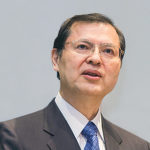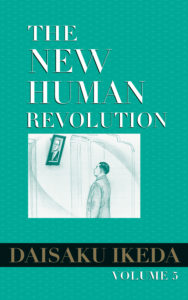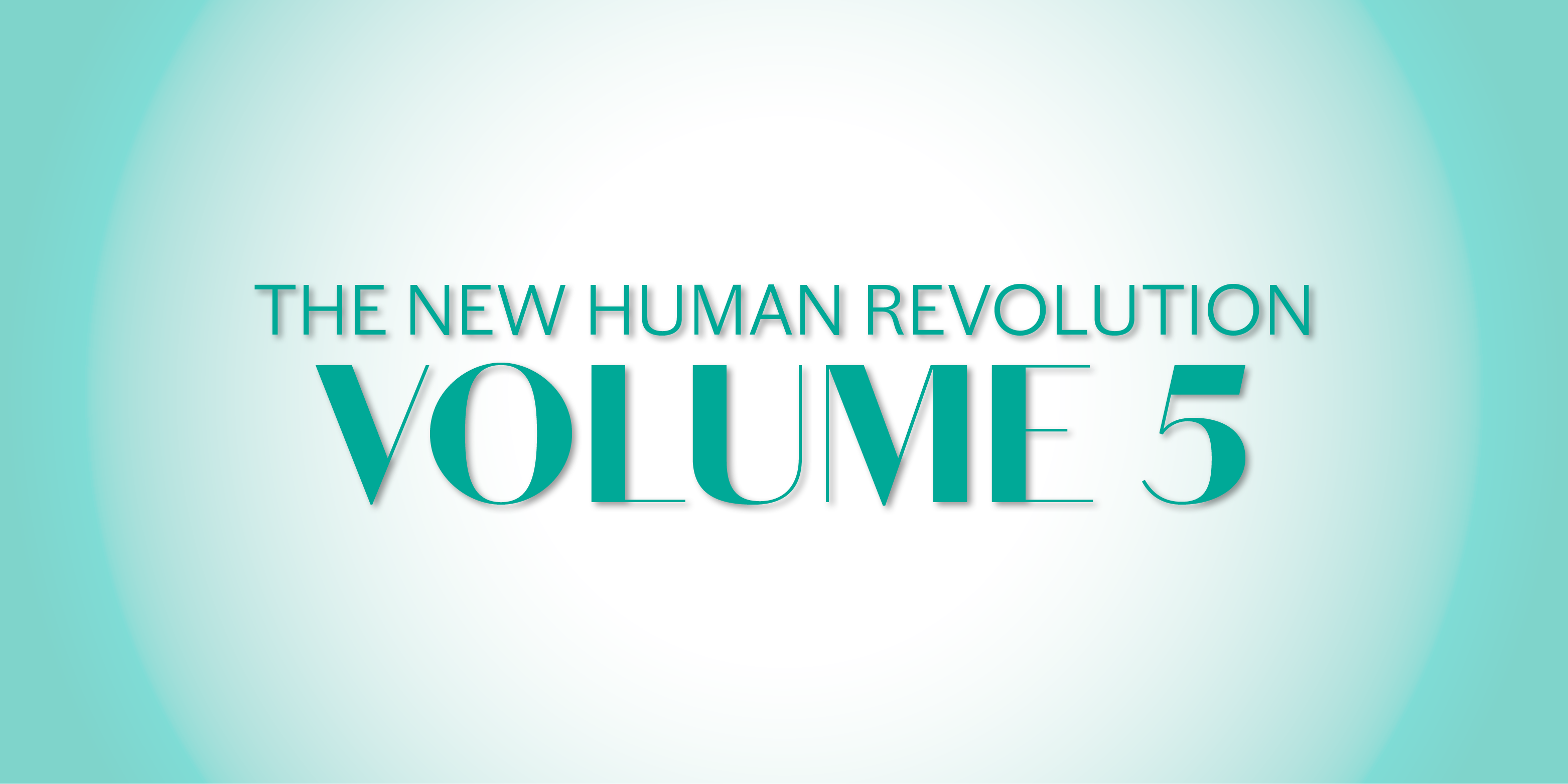 The SGI’s movement for kosen-rufu continues to develop dynamically throughout the world. The members in Europe, who held their annual Kosen-rufu Summit in January, are making great strides under the motto “One Europe with Sensei,” spearheading our movement of worldwide kosen-rufu with a burning sense of mission as pioneers.
The SGI’s movement for kosen-rufu continues to develop dynamically throughout the world. The members in Europe, who held their annual Kosen-rufu Summit in January, are making great strides under the motto “One Europe with Sensei,” spearheading our movement of worldwide kosen-rufu with a burning sense of mission as pioneers.
The “Trailblazing” and “Joy” chapters of volume 5 of The New Human Revolution continue to detail Shin’ichi Yamamoto’s first visit to Europe in October 1961. It was indeed a trailblazing journey, opening the door to peace and sowing the seeds of humanism.
Facing the Brandenburg Gate during his visit to West Germany, Shin’ichi had said with firm conviction, “I am sure that in thirty years this Berlin Wall will no longer stand.”[1] In the “Trailblazing” chapter, one of the Soka Gakkai leaders accompanying him asks if he had some specific plan in mind for bringing this about. In response, Shin’ichi talks about the importance of promoting dialogue and cultural exchange, and shares his personal determination to make this happen: “It will be a long struggle, but I will patiently work to open the way, aiming at twenty or thirty years from now.”[2] In line with these words, President Ikeda has actively sought out opportunities for dialogue and cultural exchange in the effort to blaze a path for kosen-rufu in Europe.
In Cologne, during a dinner party with some German business people, Shin’ichi talks about Buddhist humanism with reference to Goethe’s Faust. The two parties enjoy a warm and amicable exchange, chatting and singing songs. Through this experience, Shin’ichi could keenly sense a deep yearning for the teachings of Buddhism among the German people, confirming his conviction that it was indeed possible for people to transcend differences of nationality or culture and understand and empathize with one another.
In Italy, while gazing at the ancient buildings and streets of Rome, Shin’ichi comments:
Kosen-rufu was a grand undertaking to actualize world peace by building a golden palace of life, an Eternal City of the spirit, in the hearts of all human beings … It was the Soka Gakkai’s mission to accomplish that goal without fail.[3]
During this trip, he also visits the Netherlands, France, the United Kingdom, Spain, Switzerland and Austria. The visions he shares for kosen-rufu in each country, always referring to their specific history and culture, have become the inspiration and motivating guidelines for the members in Europe.
Throughout his travels, he also pours energy into nurturing core leaders. Eiji Kawasaki, whom Shin’ichi had just appointed to be the central contact person for Europe, asks him what he must do and how he should go about fulfilling this responsibility. In reply, Shin’ichi doesn’t suggest any specific course of action, aiming instead to cultivate Kawasaki’s own initiative and independence as a leader:
It is very hard to be a pioneer. You have to think of everything yourself and then do everything yourself. You have no one else to depend upon or turn to. But that’s what makes it so fulfilling and the benefits so great.[4]
The “Joy” chapter also contains the following words: “The foundation of all activities for kosen-rufu lies in the inner-motivated commitment of each individual.”[5] Naturally, discussion and consensus are important in conducting activities, but let us engrave in our hearts that kosen-rufu starts when a single individual resolves to make the peace and happiness of oneself and others their personal mission.
The Komeito Party
The “Lion” chapter describes how the Komei Political Federation, the predecessor of the present Komeito party in Japan, was formed.[6] Shin’ichi clarifies that this political organization should be a new type of political organization dedicated to the happiness of all the Japanese people, one that will serve them with a spirit of great compassion, and that it should not exist for the sake of the Soka Gakkai.
He also shares with its representatives his profound expectations for the new federation:
In the local assemblies, please remember that you are the servants of the people; help them in every way you can. I want you to be models of service, winning everyone’s praise for your tireless efforts for the welfare of your constituency’s residents. Please be lionlike in defending the people—that is my wish and hope.[7]
Here, I would like to touch upon two key imperatives on which the Soka Gakkai’s support of the Komeito party in Japan is based. The first is to keep a close watch on politics. This is something that second Soka Gakkai President Josei Toda strictly stressed, based on his strong conviction as a practitioner of Nichiren Buddhism and his insistence that ordinary people must not suffer due to corrupt politics. The second is to enable every citizen of Japan to develop sound political judgment and awareness. Politicians alone do not determine the quality of government—the voters who support and elect politicians are the decisive factor in influencing the government’s course.
In the same chapter, Shin’ichi expands upon this point: “True government reform cannot be achieved without developing the people’s conscience and awareness.”[8] The Soka Gakkai, he continues, is “awakening the people, empowering them with knowledge and opening their eyes to the direction their society is heading.”[9]
Indeed, members of the Soka Gakkai in Japan have steadfastly engaged in dialogue to awaken each individual to be a protagonist for the betterment of society. This year again, the Japanese members are taking pride in such endeavors as they work to further promote dialogue and demonstrate positive proof in their lives.
The Wellspring of Humanism
The last part of the “Lion” chapter describes the events of January 25, 1962, the day on which Shin’ichi was exonerated of all charges related to the Osaka Incident.[10]
On July 3, 1957, he had been arrested for allegedly violating the election law, charges that were all ultimately proven groundless. The trial continued for a total of 84 sessions, dragging on even after his inauguration as third president of the Soka Gakkai on May 3, 1960. During this period, despite having to appear in court 23 times, Shin’ichi remained undaunted, steadfastly working to pave the way for worldwide kosen-rufu and building the foundation of today’s Soka Gakkai.
In a message to the Divisional Representatives Conference held in January this year, President Ikeda recalled that during the trial, his lawyers had told him to prepare for a guilty verdict. Nevertheless, some members who had practiced with him since the youth division worked ceaselessly to prove how unjust the police investigation had been.
This is also recorded in detail in “The Trial” chapter in volume 11 of The Human Revolution. It describes how the vow to dedicate his life to the struggle for human rights began to take root in Shin’ichi’s heart as a result of the Osaka ordeal. This vow, it states, “would eventually become the source of a fresh current of humanism that would spread widely throughout the globe in the form of the SGI movement.”[11]
It is the foundation of the SGI’s movement for peace, culture and education, and I believe inheriting this vow is the mission and responsibility of all his disciples.
Translated from the February 27, 2019, issue of the Seikyo Shimbun, the Soka Gakkai’s daily newspaper.
Summary of Contents
 Trailblazing
Trailblazing
Shin’ichi Yamamoto travels from Germany to France and the United Kingdom.
Joy
In Vienna, Shin’ichi pays tribute to the life and struggles of Beethoven. In Rome, reflecting on the history of Christianity, he envisages a brilliant future for the propagation of the Mystic Law.
Victory
One hundred thousand members participate in a young men’s division general meeting, while 85,000 young women gather for their general meeting.
Lion
On January 17, 1962, the Komei Political Federation is formed. On January 25, Shin’ichi is cleared of all charges against him in connection with the Osaka Incident.
This book is available at https://bookstore.sgi-usa.org.
References
- Daisaku Ikeda, The New Human Revolution, vol. 4, revised edition (Santa Monica, California: World Tribune Press, 2019), p. 319. ↩︎
- Daisaku Ikeda, The New Human Revolution, vol. 5, (Santa Monica, California: World Tribune Press, 2013), p. 5. ↩︎
- Ibid., pp. 144–45. ↩︎
- Ibid., p. 73. ↩︎
- Ibid., p. 74. ↩︎
- The Komeito (clean government party) is a political party in Japan. On October 21, 1991, the SGI directors resolved that, with the exception of Japan where such activities have a certain history, the SGI and SGI constituent organizations shall not carry out any political activities whatsoever or participate in specific political parties or political organizations. ↩︎
- The New Human Revolution, vol. 5, p. 268. ↩︎
- Ibid., p. 267. ↩︎
- Ibid., p. 267. ↩︎
- Osaka Incident: SGI President Ikeda, then Soka Gakkai youth division chief of staff, was arrested on July 3, 1957, and wrongfully charged with violations of the election law in a House of Councillors by-election held in Osaka earlier that year. At the end of the court case, which lasted for more than four years, he was fully exonerated ↩︎
- Daisaku Ikeda, The Human Revolution, vol. 11, (Santa Monica, California: World Tribune Press, 2004), p. 1713. ↩︎
You are reading {{ meterCount }} of {{ meterMax }} free premium articles

